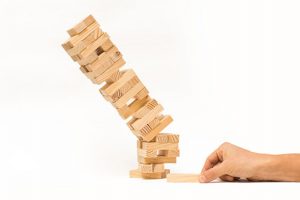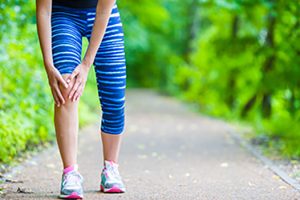
When there’s an element of instability in your feet, the rest of your body has to compensate to keep you upright.
Ever play Jenga? Jenga is the delightful party game that pits your patience and daring against the structural integrity of dozens of wooden bricks, stacked into a tower. The players take turns removing bricks from below and balancing them on the top. As the tower loses its foundational supports, the top begins to wobble. Eventually, gravity wins out, and the whole, hole-y structure comes crumbling down.
Your body is a little like a Jenga tower, except instead of regular-shaped bricks, you’ve got hundreds of wacky-shaped bones and soft tissues. And they’re all trying to move together in perfect coordination, to get you to the fridge, to the bus stop, or all the way through to the finish line.
When your knee or hip joints start to act up, you should look a little lower for the cause of the problem: your feet!
Your knees and hips are near the top of the tower, while your feet make up the base. When there’s an element of instability in your feet, the rest of your body has to compensate to keep you upright. This can cause changes to your gait, which can inflict real damage to the joints up top, causing you pain and slowing you down.
Hip and knee pain and overpronation
Your knee is the largest and most complex joint of your body, and it actually comprises three different joints between the femur, the tibia, and the patella (kneecap). It’s also one of the joints most vulnerable to injury.
The knee is extremely good at doing what it was designed to do – bend straight backward. But if you force the knee to bend when one of the bones is twisted – even slightly – that strains it. And hurts the joint. A similar process can affect the hip as well.
So how do the bones get twisted? Well, one way is through an acute injury, like a meniscus or ACL tear. This happens suddenly, and with a quick burst of sharp pain. The exact moment of injury will be embedded in your brain.
Another way bones get twisted is through overpronation. When you take a step, your foot pronates as it rolls inward to cushion the landing. This is normal. But if you have flat feet or other structural problems, you might be prone to overpronate: this means the arch collapses, allowing your foot to roll too much.
You may have been overpronating your entire life, and only now started to experience hip or knee pain. Fortunately, this problem can be corrected easily with custom orthotics. An orthotic can support the arch, keeping your foot and leg in alignment, to protect your knees and hips from excessive wear-and-tear.
Osteoarthritis of the hip or knee can make walking difficult

Walking with osteoarthritis can cause pain, swelling, and stiffness in the joint.
Did you know that the knee is one of the most common areas of the body to develop osteoarthritis? Osteoarthritis is a progressive disease in which the soft, cartilaginous cushion between the bones wears away, leaving the joint unprotected from the friction of movement.
The risk of osteoarthritis increases with age, and it can be genetic. But anyone, at any age, can develop osteoarthritis. Other contributors to osteoarthritis risk include a trauma to the joint, excessive activity, and obesity.
Forget running, or even low-impact exercises like cycling – just walking with osteoarthritis can cause pain, swelling, and stiffness in the joint. But, according to new research, a special type of walking could serve as a short-term solution to arthritis pain.
It’s called “gait retraining,” and it could stave off degeneration and delay, or eliminate, the need for surgery.
Arthritis patients tend to change the way they walk to mitigate their pain
But this causes more problems. “Over time, they wear out other joints due to compensations they make for the painful joint,” says Dr. Kevin Stone, orthopedic surgeon and chairman of the Stone Research Foundation in San Francisco.
However, a small change to the way you walk may slow or even reverse the damage of arthritis. A study published in the Journal of Orthopaedic Research found that by pointing their toes slightly inward as they walk, patients can take pressure of the knee, reduce pain, and increase their range of motion. After one month of training, a change of only 7 degrees improved function by about 30%.
Experiencing hip or knee pain? Visit your foot and ankle specialist.
It might seem counter-intuitive, but if you’re experiencing pain in the hip or knee, make an appointment with your foot and ankle specialist. The doctors at University Foot and Ankle Institute can assess your foot structure, evaluate your gait, and recommend conservative solutions that can help you to avoid surgery in the future.
If you are experiencing problems with your feet or ankles we are here to help. Our nationally recognized podiatrists and foot and ankle specialists offer the most advanced foot and ankle care along with the highest success rates in the nation. We are leaders in the field of research and treatment of all foot and ankle conditions.
For more information or to schedule a consultation, please call (877) 736-6001 or visit us at www.footankleinstitute.com.
- Revolutionizing Extremity Imaging: UFAI’s Open MRI for the Foot and Ankle - October 21, 2023
- Youth Sports and Heel Pain: Should Kids Play with Pain? - April 4, 2023
- All About Foot Arch Pain and Foot Arch Cramps - March 15, 2021